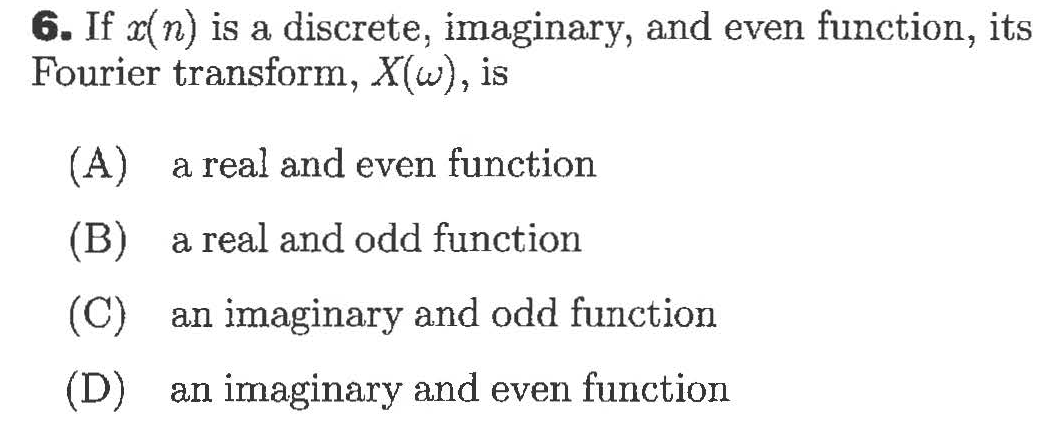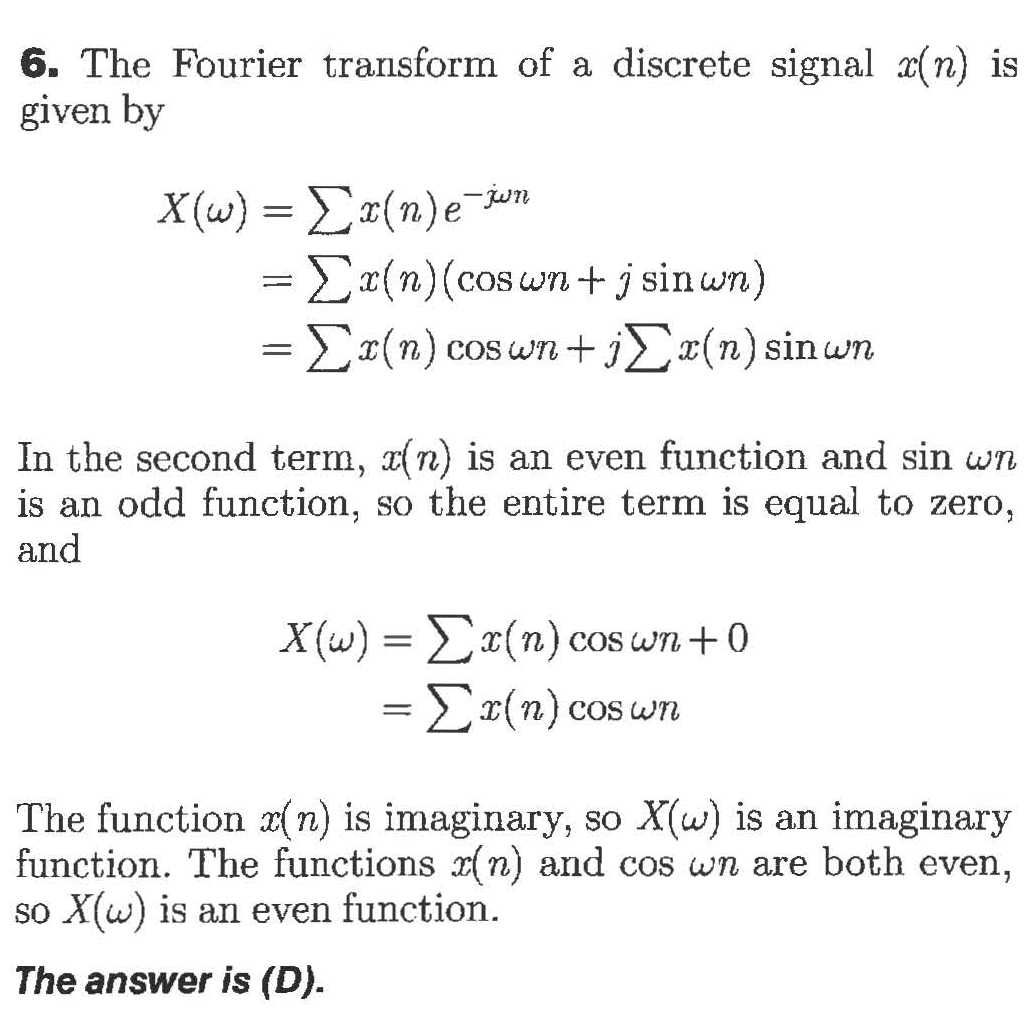6. If x(n) is a discrete, imaginary, and even function, its Fourier transform, X(w), is (A) a real and even function (В) a real and odd function (C) an imaginary and odd function (D) an imaginary and even function 6. The Fourier transform of a discrete signal a(n) is given by Χ(ω)Σε(n) εTψη =x(n)(coswn+ j sinwn) 1 Σ(n) coswn + jΣ-(n) sin wn In the second term, n) is an even function and sin wn is an odd function, so the entire term is equal to zero, and x(n) cos wn+0 -Σ(n)cos un X(w) The function z(n) is imaginary, so X(w) is an imaginary function. The functions x(n) and cos wn are both even, so X(w) is an even function The answer is (D)
6. If x(n) is a discrete, imaginary, and even function, its Fourier transform, X(w), is (A) a real and even function (В) a real and odd function (C) an imaginary and odd function (D) an imaginary and even function 6. The Fourier transform of a discrete signal a(n) is given by Χ(ω)Σε(n) εTψη =x(n)(coswn+ j sinwn) 1 Σ(n) coswn + jΣ-(n) sin wn In the second term, n) is an even function and sin wn is an odd function, so the entire term is equal to zero, and x(n) cos wn+0 -Σ(n)cos un X(w) The function z(n) is imaginary, so X(w) is an imaginary function. The functions x(n) and cos wn are both even, so X(w) is an even function The answer is (D)
Introductory Circuit Analysis (13th Edition)
13th Edition
ISBN:9780133923605
Author:Robert L. Boylestad
Publisher:Robert L. Boylestad
Chapter1: Introduction
Section: Chapter Questions
Problem 1P: Visit your local library (at school or home) and describe the extent to which it provides literature...
Related questions
Question
100%
Hi,
the attached image shows a question and its answer but still, I couldn't understand it please simply explain it

Transcribed Image Text:6. If x(n) is a discrete, imaginary, and even function, its
Fourier transform, X(w), is
(A)
a real and even function
(В)
a real and odd function
(C)
an imaginary and odd function
(D)
an imaginary and even function

Transcribed Image Text:6. The Fourier transform of a discrete signal a(n) is
given by
Χ(ω)Σε(n) εTψη
=x(n)(coswn+ j sinwn)
1
Σ(n) coswn + jΣ-(n) sin wn
In the second term, n) is an even function and sin wn
is an odd function, so the entire term is equal to zero,
and
x(n) cos wn+0
-Σ(n)cos un
X(w)
The function z(n) is imaginary, so X(w) is an imaginary
function. The functions x(n) and cos wn are both even,
so X(w) is an even function
The answer is (D)
Expert Solution
This question has been solved!
Explore an expertly crafted, step-by-step solution for a thorough understanding of key concepts.
This is a popular solution!
Trending now
This is a popular solution!
Step by step
Solved in 4 steps with 3 images

Knowledge Booster
Learn more about
Need a deep-dive on the concept behind this application? Look no further. Learn more about this topic, electrical-engineering and related others by exploring similar questions and additional content below.Recommended textbooks for you

Introductory Circuit Analysis (13th Edition)
Electrical Engineering
ISBN:
9780133923605
Author:
Robert L. Boylestad
Publisher:
PEARSON

Delmar's Standard Textbook Of Electricity
Electrical Engineering
ISBN:
9781337900348
Author:
Stephen L. Herman
Publisher:
Cengage Learning

Programmable Logic Controllers
Electrical Engineering
ISBN:
9780073373843
Author:
Frank D. Petruzella
Publisher:
McGraw-Hill Education

Introductory Circuit Analysis (13th Edition)
Electrical Engineering
ISBN:
9780133923605
Author:
Robert L. Boylestad
Publisher:
PEARSON

Delmar's Standard Textbook Of Electricity
Electrical Engineering
ISBN:
9781337900348
Author:
Stephen L. Herman
Publisher:
Cengage Learning

Programmable Logic Controllers
Electrical Engineering
ISBN:
9780073373843
Author:
Frank D. Petruzella
Publisher:
McGraw-Hill Education

Fundamentals of Electric Circuits
Electrical Engineering
ISBN:
9780078028229
Author:
Charles K Alexander, Matthew Sadiku
Publisher:
McGraw-Hill Education

Electric Circuits. (11th Edition)
Electrical Engineering
ISBN:
9780134746968
Author:
James W. Nilsson, Susan Riedel
Publisher:
PEARSON

Engineering Electromagnetics
Electrical Engineering
ISBN:
9780078028151
Author:
Hayt, William H. (william Hart), Jr, BUCK, John A.
Publisher:
Mcgraw-hill Education,